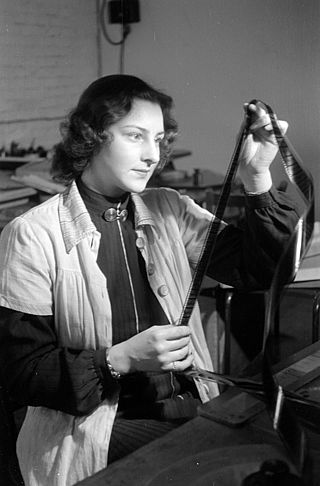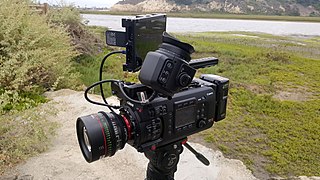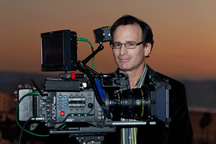In film and television production, B-roll, B roll, B-reel or B reel is supplemental or alternative footage intercut with the main shot. [1] The term A-roll, referring to main footage, has fallen out of use. [2]
In film and television production, B-roll, B roll, B-reel or B reel is supplemental or alternative footage intercut with the main shot. [1] The term A-roll, referring to main footage, has fallen out of use. [2]
Films and videos may cut away from the main story to show related scenery or action. Establishing shots may be used to show the audience the context of the story. These secondary images are often presented without sound, or with very low level sound, as the sound from the primary footage is expected to continue while the other images are shown. The various shots presented without sound are called B-roll. [3]
B-roll may be shot by smaller second unit crews, since there is no need for sound. In film, smaller MOS cameras, lacking sound circuitry, may be used for greater portability and ease of setup. [3] In electronic news-gathering (ENG) and documentary film projects, B-roll footage is often shot after the main interview is shot, to provide supporting scenes for what was said by the interview subject. [2] In a docudrama project, B-roll may refer to dramatic re-enactment scenes staged by the producer and performed by actors, to be used as cutaway shots. [4]
There are many different types of B-roll, including: insert shots, FX shots, establishing shots, stock footage, and pickup shots. [5]
B-roll footage may be added to or drawn from a stock footage library. [1] [4]

The term B-roll originates from a particular solution to the problem of visible splices in the narrow film stock used in 16 mm film. 35 mm film was wide enough to hide splices, but 16 mm film revealed the splices as flaws in the picture. To avoid this problem, the intended shots were spliced to opaque black leader, with the black leader hiding the splice. Two sequences of shots were assembled, the odd-numbered shots on the A-roll, and the even-numbered shots on the B-roll, such that all of the shots on one roll were matched by black leader on the other roll, in a checkerboard pattern (an alternate name for the process was "checkerboard printing".) Unexposed 16 mm raw print stock was exposed twice, once to the A-roll, then it was exposed again to the B-roll. [6] [7] [8]
Until the mid-1970s, news teams shot both main A-roll and secondary B-roll footage on 16 mm film. Sound was integrated onto the film by way of a magnetic stripe at the edge of the film. The A-roll and B-roll scenes, shot at 24 frames per second, were converted to the television frame rate of 30 fps using a telecine system consisting of two film projectors, one showing the main A-roll footage and the other showing the B-roll. The sound from the A-roll footage was used, or sound from narration or voiceover, while MOS images from the B-roll were intercut as desired. [2]
In the 1980s, the term B-roll was adopted for linear video editing using at least two video tape machines. Traditionally, the tape decks in an edit suite were labeled by letter, with the 'A' deck being the one containing the main tape upon which the main action material was shot. The 'B' deck was used to run tapes that held additional footage such as establishing shots, cutaway shots, and any other supporting footage. The sound was usually taken from the A deck alone, so that the B deck provided video without sound. [3] As linear editing systems were unable to dissolve between clips on the same tape, an edit decision list (EDL) was used to mark clips as "A-roll" and "B-roll" to indicate source machines.

Film editing is both a creative and a technical part of the post-production process of filmmaking. The term is derived from the traditional process of working with film which increasingly involves the use of digital technology. When putting together some sort of video composition, typically, you’d need a collection of shots and footage that vary from one another. The act of adjusting the shots you’ve already taken, and turning them into something new is known as film editing.
The film industry is built upon many technologies and techniques, drawing upon photography, stagecraft, music, and many other disciplines. Following is an index of specific terminology applicable thereto.

Super 8 mm film is a motion-picture film format released in 1965 by Eastman Kodak as an improvement over the older "Double" or "Regular" 8 mm home movie format.

Kinescope, shortened to kine, also known as telerecording in Britain, is a recording of a television programme on motion picture film, directly through a lens focused on the screen of a video monitor. The process was pioneered during the 1940s for the preservation, re-broadcasting and sale of television programmes before the introduction of quadruplex videotape, which from 1956 eventually superseded the use of kinescopes for all of these purposes. Kinescopes were the only practical way to preserve live television broadcasts prior to videotape.

A movie camera is a type of photographic camera that rapidly takes a sequence of photographs, either onto film stock or an image sensor, in order to produce a moving image to display on a screen. In contrast to the still camera, which captures a single image at a time, the movie camera takes a series of images by way of an intermittent mechanism or by electronic means; each image is a frame of film or video. The frames are projected through a movie projector or a video projector at a specific frame rate to show the moving picture. When projected at a high enough frame rate, the persistence of vision allows the eyes and brain of the viewer to merge the separate frames into a continuous moving picture.

Video editing is the manipulation and arrangement of video shots. Video editing is used to structure and present all video information, including films and television shows, video advertisements and video essays. Video editing has been dramatically democratized in recent years by editing software available for personal computers. Editing video can be difficult and tedious, so several technologies have been produced to aid people in this task. Pen based video editing software was developed in order to give people a more intuitive and fast way to edit video.
Linear video editing is a video editing post-production process of selecting, arranging and modifying images and sound in a predetermined, ordered sequence. Regardless of whether it was captured by a video camera, tapeless camcorder, or recorded in a television studio on a video tape recorder (VTR) the content must be accessed sequentially.

A clapperboard, also known as a dumb slate, is a device used in filmmaking and video production to assist in synchronizing of picture and sound, and to designate and mark the various scenes and takes as they are filmed and audio-recorded. It is operated by the clapper loader. It is said to have been invented by Australian filmmaker F. W. Thring.

Electronic news gathering (ENG) or electronic journalism (EJ) is usage of electronic video and audio technologies by reporters to gather and present news instead of using film cameras. The term was coined during the rise of videotape technology in the 1970s. ENG can involve anything from a single reporter with a single professional video camera, to an entire television crew taking a truck on location.
Film-out is the process in the computer graphics, video production and filmmaking disciplines of transferring images or animation from videotape or digital files to a traditional film print. Film-out is a broad term that encompasses the conversion of frame rates, color correction, as well as the actual printing, also called scannior recording.
Video production is the process of producing video content for video. It is the equivalent of filmmaking, but with video recorded either as analog signals on videotape, digitally in video tape or as computer files stored on optical discs, hard drives, SSDs, magnetic tape or memory cards instead of film stock. There are three stages of video production: pre-production, production, and post-production. Pre-production involves all of the planning aspects of the video production process before filming begins. This includes scriptwriting, scheduling, logistics, and other administrative duties. Production is the phase of video production which captures the video content and involves filming the subject(s) of the video. Post-production is the action of selectively combining those video clips through video editing into a finished product that tells a story or communicates a message in either a live event setting, or after an event has occurred (post-production).

In filmmaking and video production, footage is raw, unedited material as originally filmed by a movie camera or recorded by a video camera, which typically must be edited to create a motion picture, video clip, television show or similar completed work.
In filmmaking, dailies are the raw, unedited footage shot during the making of a motion picture. The term comes from when movies were all shot on film because usually at the end of each day, the footage was developed, synced to sound, and printed on film in a batch for viewing the next day by the director, selected actors, and film crew members. After the advent of digital filmmaking, "dailies" were available instantly after the take and the review process was no longer tied to the overnight processing of film and became more asynchronous. Now some reviewing may be done at the shoot, even on location, and raw footage may be immediately sent electronically to anyone in the world who needs to review the takes. For example, a director can review takes from a second unit while the crew is still on location or producers can get timely updates while travelling. Dailies serve as an indication of how the filming and the actors' performances are progressing. The term was also used to describe film dailies as "the first positive prints made by the laboratory from the negative photographed on the previous day".

Digital cinematography is the process of capturing (recording) a motion picture using digital image sensors rather than through film stock. As digital technology has improved in recent years, this practice has become dominant. Since the mid-2010s, most movies across the world are captured as well as distributed digitally.
Offline editing is the creative storytelling stage of film making and television production where the structure, mood, pacing and story of the final show are defined. Many versions and revisions are presented and considered at this stage until the edit gets to a stage known as picture lock. This is when the process then moves on to the next stages of post production known as online editing, colour grading and audio mixing.
Negative cutting is the process of cutting motion picture negative to match precisely the final edit as specified by the film editor. Original camera negative (OCN) is cut with scissors and joined using a film splicer and film cement. Negative cutting is part of the post-production process and occurs after editing and prior to striking internegatives and release prints. The process of negative cutting has changed little since the beginning of cinema in the early 20th century. In the early 1980s computer software was first used to aid the cutting process. Kodak introduced barcode on motion picture negative in the mid-1990s. This enabled negative cutters to more easily track shots and identify film sections based on keykode.
MOS is a standard filmmaking jargon acronym used in production reports to indicate an associated film segment has no synchronous audio track.

Hand-held camera or hand-held shooting is a filmmaking and video production technique in which a camera is held in the camera operator's hands as opposed to being mounted on a tripod or other base. Hand-held cameras are used because they are conveniently sized for travel and because they allow greater freedom of motion during filming. Newsreel camera operators frequently gathered images using a hand-held camera. Virtually all modern video cameras are small enough for hand-held use, but many professional video cameras are designed specifically for hand-held use such as for electronic news-gathering (ENG), and electronic field production (EFP).
In the post-production process of film editing and video editing, a cut is an abrupt, but usually trivial film transition from one sequence to another. It is synonymous with the term edit, though "edit" can imply any number of transitions or effects. The cut, dissolve, and wipe serve as the three primary transitions. The term refers to the physical action of cutting film or videotape, but also refers to a similar edit performed in software; it has also become associated with the resulting visual "break".

Rolling Stones: Live at the Max is a concert film by the Rolling Stones released in 1991. It was specially filmed in IMAX during the Urban Jungle Tour in Europe in 1990. It was the first concert movie shot in the IMAX format.